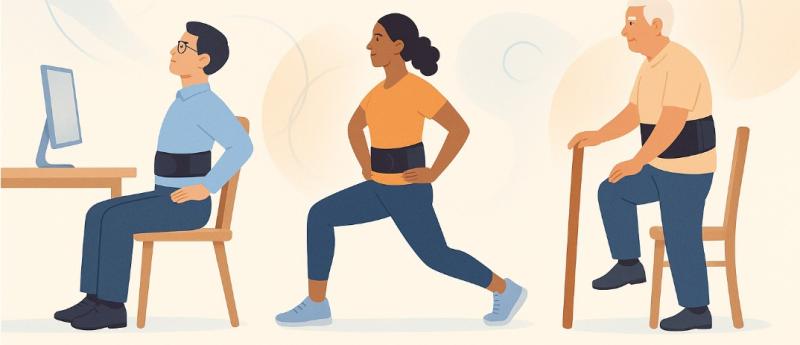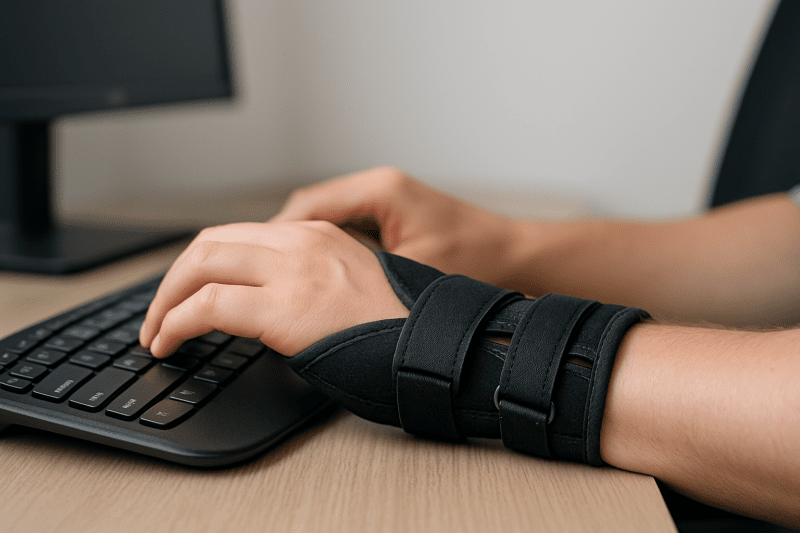Spending long hours at a desk often leads to the same frustrating problem: persistent back and shoulder discomfort that sneaks up as the day goes on. Long hours of sitting can pull your shoulders forward, weaken your core, and train your body into poor posture that follows you long after you log off. The good news? A back brace for office posture can help retrain your alignment, support your spine, and reduce strain so you can work more comfortably.
This guide breaks down how back braces support desk workers, what features matter most, and how to use one safely throughout your workday.
Why Office Workers Struggle With Posture
Desks, monitors, and chairs often aren’t set up for real human bodies. Over time, this leads to:
-
Rounded shoulders
-
Forward head posture
-
Lower-back compression
-
Weak core and mid-back muscles
-
Midday stiffness and fatigue
Even with good ergonomics, you’re still fighting gravity for 8–10 hours a day. A posture-supporting back brace bridges that gap.
How a Back Brace Helps Improve Office Posture
A back brace for office posture does three essential things:
✔️ Encourages Neutral Alignment
It gently pulls the shoulders back and keeps the spine in a more natural, upright position—without feeling restrictive.
✔️ Reduces Muscle Fatigue
Poor posture forces small stabilizer muscles to work overtime. A brace shares the load so those muscles can rest and recover.
✔️ Provides Gentle Correction
Over time, your body begins to “remember” good posture, even when the brace isn’t on.
✔️ Improves Comfort During Long Sitting Sessions
Better alignment = less compression on your lower spine and reduced upper-back tension.
Who Should Consider a Posture Brace at Work?
A back brace is especially helpful for office workers who experience:
-
End-of-day shoulder or neck pain
-
Slouching or rounded shoulders
-
Lower-back fatigue
-
Difficulty maintaining upright posture
-
The feeling of “collapsing forward” after long hours at a desk
If that sounds familiar, you’re exactly the person posture braces are made for.
Choosing the Best Back Brace for Office Posture
Not all braces are created equal—especially for desk use. Look for features that support natural posture without restricting movement.
1. Lightweight and Breathable Material
You’re wearing it for hours, so comfort matters. Mesh or breathable neoprene works well.
2. Adjustable Shoulder Straps
This allows a customized fit without digging into your skin.
3. Slim, Under-Clothing Design
For office use, discreet is ideal. A slim brace fits easily under shirts or sweaters.
4. Upper-Back Focused Support
Clavicle-style braces work well for rounding, while hybrid models support both upper and lower back.
5. Gentle Resistance, Not Rigidity
A brace shouldn’t “force” you upright—it should guide you there.
How to Use a Back Brace at Work (The Right Way)
⏱️ Start with 30–60 minutes a day
Let your body adapt to the new posture.
⬆️ Gradually increase to 2–3 hours
Aim for periodic use, not all-day wear. Back braces are posture trainers, not crutches.
🪑 Pair it with better ergonomics
Small upgrades (monitor height, lumbar support, wrist position) magnify your results.
💪 Add a little movement
Posture-friendly exercises—shoulder rolls, seated core holds, and mobility breaks—help your muscles adapt.
When a Posture Brace Isn’t Enough
If you have:
-
Severe, radiating back pain
-
Numbness or tingling
-
A diagnosed spinal condition
A brace may not be the full solution. Always check with a clinician if symptoms persist.
For office workers battling daily slouching, a back brace for office posture can be a simple, affordable tool that supports better alignment, reduces discomfort, and helps retrain your body into healthier habits. Used consistently (but not constantly), it can make your desk life noticeably more comfortable.
🚨Don’t miss our foundational guide: Best Back Brace to Help With Posture



